Scsc 301 tamu exam 2 Study guides, Class notes & Summaries
Looking for the best study guides, study notes and summaries about Scsc 301 tamu exam 2? On this page you'll find 10 study documents about Scsc 301 tamu exam 2.
All 10 results
Sort by
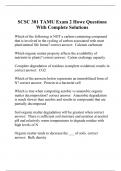
-
SCSC 301 TAMU Exam 2 Howe Questions With Complete Solutions
- Exam (elaborations) • 8 pages • 2023
-
Available in package deal
-
- $11.49
- + learn more
Which of the following is NOT a carbon-containing compound that is involved in the cycling of carbon associated with most plant/animal life forms? correct answer: Calcium carbonate Which organic matter property affects the availability of nutrients to plants? correct answer: Cation exchange capacity Complete degradation of residues (complete oxidation) results in correct answer: CO2 Which of the answers below represents an immobilized form of N? correct answer: Protein in a bacteria...
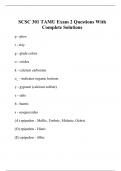
-
SCSC 301 TAMU Exam 2 Questions With Complete Solutions
- Exam (elaborations) • 4 pages • 2023
-
Available in package deal
-
- $10.99
- + learn more
p - plow t - clay g - glade colors o - oxides k - calcium carbonate o_ - indicates organic horizon y - gypsum (calcium sulfate) z - salts h - humis s - sesquioxides (A) epipedon - Mollic, Umbric, Melanic, Ochric (O) epipedon - Histic (E) epipedon - Albic (Bw) epipedon - Cambric (Bt) epipedon - Argillic (Bo) epipedon - Oxic (Bhs) epipedon - Spodic (Bk) epipedon - Calcic (Bkm) epipedon - petrocalcic (By) epipedon - Gypsic (Bym) epipedon -...
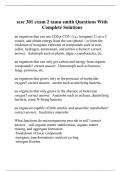
-
scsc 301 exam 2 tamu smith Questions With Complete Solutions
- Exam (elaborations) • 11 pages • 2023
-
Available in package deal
-
- $12.99
- + learn more
an organism that can use CO2or CO3- (i.e., inorganic C) as a C source, and obtain energy from the sun (photo) - or from the oxidation of inorganic elements or compounds such as iron, sulfur, hydrogen, ammonium, and nitrites (chemo)? correct answer: Autotroph such as plants, algae, cyanobacteria, etc. an organism that can only get carbon and energy from organic compounds? correct answer: Heterotroph such as bacteria, fungi, protozoa, etc. an organism that grows only in the presence of mol...
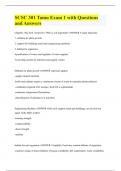
-
SCSC 301 Tamu Exam 1 with Questions and Answers
- Exam (elaborations) • 53 pages • 2024
-
- $7.99
- + learn more
SCSC 301 Tamu Exam 1 with Questions and Answers Chapter1 The Soils Around Us: Why is soil important? ANSWER 5 major functions: 1. medium for plant growth 2. support for buildings and roads (engineering medium) 3. habitat for organisms ication of waters and regulator of water supplies ling system for nutrients and organic wastes Medium for plant growth ANSWER -physical support -supply mineral nutrients -hold water (plants require a continuous stream of water to maintain photosynthes...
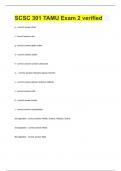
-
SCSC 301 TAMU Exam 2 verified
- Exam (elaborations) • 4 pages • 2023
-
Available in package deal
-
- $15.49
- + learn more
SCSC 301 TAMU Exam 2 verified p - correct answer plow t - correct answer clay g - correct answer glade colors o - correct answer oxides k - correct answer calcium carbonate o_ - correct answer indicates organic horizon y - correct answer gypsum (calcium sulfate) z - correct answer salts h - correct answer humis s - correct answer sesquioxides (A) epipedon - correct answer Mollic, Umbric, Melanic, Ochric (O) epipedon - correct answer Histic (E) epipedon - c...
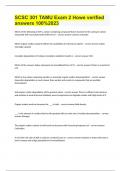
-
SCSC 301 TAMU Exam 2 Howe verified answers 100%2023
- Exam (elaborations) • 6 pages • 2023
-
Available in package deal
-
- $14.99
- + learn more
SCSC 301 TAMU Exam 2 Howe verified answers 100%2023 Which of the following is NOT a carbon-containing compound that is involved in the cycling of carbon associated with most plant/animal life forms? - correct answer Calcium carbonate Which organic matter property affects the availability of nutrients to plants? - correct answer Cation exchange capacity Complete degradation of residues (complete oxidation) results in - correct answer CO2 Which of the answers below represents an immobi...
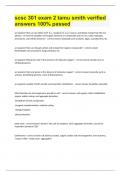
-
scsc 301 exam 2 tamu smith verified answers 100% passed
- Exam (elaborations) • 9 pages • 2023
-
Available in package deal
-
- $15.49
- + learn more
scsc 301 exam 2 tamu smith verified answers 100% passed an organism that can use CO2or CO3- (i.e., inorganic C) as a C source, and obtain energy from the sun (photo) - or from the oxidation of inorganic elements or compounds such as iron, sulfur, hydrogen, ammonium, and nitrites (chemo)? - correct answer Autotroph such as plants, algae, cyanobacteria, etc. an organism that can only get carbon and energy from organic compounds? - correct answer Heterotroph such as bacteria, fungi, protozoa...
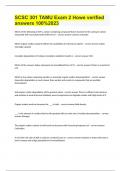
-
SCSC 301 TAMU Exam 2 Howe verified answers 100%2023
- Exam (elaborations) • 6 pages • 2023
- Available in package deal
-
- $12.99
- + learn more
SCSC 301 TAMU Exam 2 Howe verified answers 100%2023
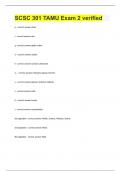
-
SCSC 301 TAMU Exam 2 verified
- Exam (elaborations) • 4 pages • 2023
- Available in package deal
-
- $12.99
- + learn more
SCSC 301 TAMU Exam 2 verified
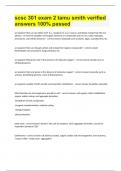
-
scsc 301 exam 2 tamu smith verified answers 100% passed
- Exam (elaborations) • 9 pages • 2023
- Available in package deal
-
- $13.99
- + learn more
scsc 301 exam 2 tamu smith verified answers 100% passed

That summary you just bought made someone very happy. Also get paid weekly? Sell your study resources on Stuvia! Discover all about earning on Stuvia


